Detailed Analysis of Woolworths' Cash Flow, OCI, and Corporate Tax
VerifiedAdded on 2021/06/17
|10
|2924
|160
Report
AI Summary
This report provides a detailed analysis of Woolworths Limited's financial statements, focusing on the cash flow statement, other comprehensive income (OCI), and corporate income tax. The analysis of the cash flow statement examines the inflows and outflows related to operating, investing, and financing activities over three years, including a comparative analysis of key items like receipts from customers, payments to suppliers, and dividends. The report also explores the components of OCI, such as hedging reserves, foreign currency translation, and equity instruments reserves, explaining their accounting treatment and why they are not reported in the profit and loss statement. Furthermore, it delves into the company's corporate income tax, detailing the current tax expense and any differences between accounting income and taxable income. The report concludes with an overall assessment of the company's financial performance, offering recommendations based on the findings.

Paraphrase This Document
Need a fresh take? Get an instant paraphrase of this document with our AI Paraphraser
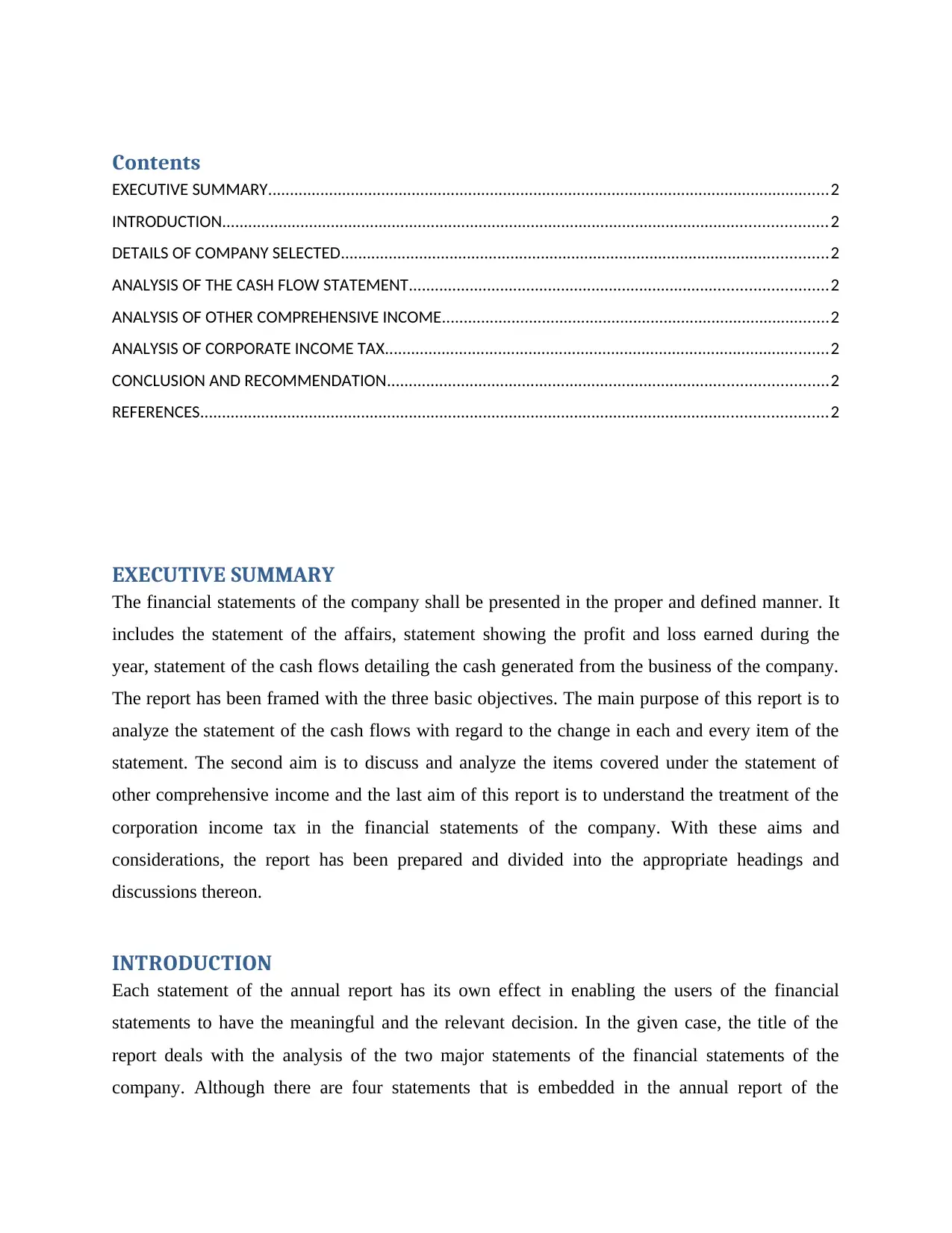
Contents
EXECUTIVE SUMMARY.................................................................................................................................2
INTRODUCTION...........................................................................................................................................2
DETAILS OF COMPANY SELECTED................................................................................................................2
ANALYSIS OF THE CASH FLOW STATEMENT................................................................................................2
ANALYSIS OF OTHER COMPREHENSIVE INCOME.........................................................................................2
ANALYSIS OF CORPORATE INCOME TAX......................................................................................................2
CONCLUSION AND RECOMMENDATION.....................................................................................................2
REFERENCES................................................................................................................................................2
EXECUTIVE SUMMARY
The financial statements of the company shall be presented in the proper and defined manner. It
includes the statement of the affairs, statement showing the profit and loss earned during the
year, statement of the cash flows detailing the cash generated from the business of the company.
The report has been framed with the three basic objectives. The main purpose of this report is to
analyze the statement of the cash flows with regard to the change in each and every item of the
statement. The second aim is to discuss and analyze the items covered under the statement of
other comprehensive income and the last aim of this report is to understand the treatment of the
corporation income tax in the financial statements of the company. With these aims and
considerations, the report has been prepared and divided into the appropriate headings and
discussions thereon.
INTRODUCTION
Each statement of the annual report has its own effect in enabling the users of the financial
statements to have the meaningful and the relevant decision. In the given case, the title of the
report deals with the analysis of the two major statements of the financial statements of the
company. Although there are four statements that is embedded in the annual report of the
EXECUTIVE SUMMARY.................................................................................................................................2
INTRODUCTION...........................................................................................................................................2
DETAILS OF COMPANY SELECTED................................................................................................................2
ANALYSIS OF THE CASH FLOW STATEMENT................................................................................................2
ANALYSIS OF OTHER COMPREHENSIVE INCOME.........................................................................................2
ANALYSIS OF CORPORATE INCOME TAX......................................................................................................2
CONCLUSION AND RECOMMENDATION.....................................................................................................2
REFERENCES................................................................................................................................................2
EXECUTIVE SUMMARY
The financial statements of the company shall be presented in the proper and defined manner. It
includes the statement of the affairs, statement showing the profit and loss earned during the
year, statement of the cash flows detailing the cash generated from the business of the company.
The report has been framed with the three basic objectives. The main purpose of this report is to
analyze the statement of the cash flows with regard to the change in each and every item of the
statement. The second aim is to discuss and analyze the items covered under the statement of
other comprehensive income and the last aim of this report is to understand the treatment of the
corporation income tax in the financial statements of the company. With these aims and
considerations, the report has been prepared and divided into the appropriate headings and
discussions thereon.
INTRODUCTION
Each statement of the annual report has its own effect in enabling the users of the financial
statements to have the meaningful and the relevant decision. In the given case, the title of the
report deals with the analysis of the two major statements of the financial statements of the
company. Although there are four statements that is embedded in the annual report of the
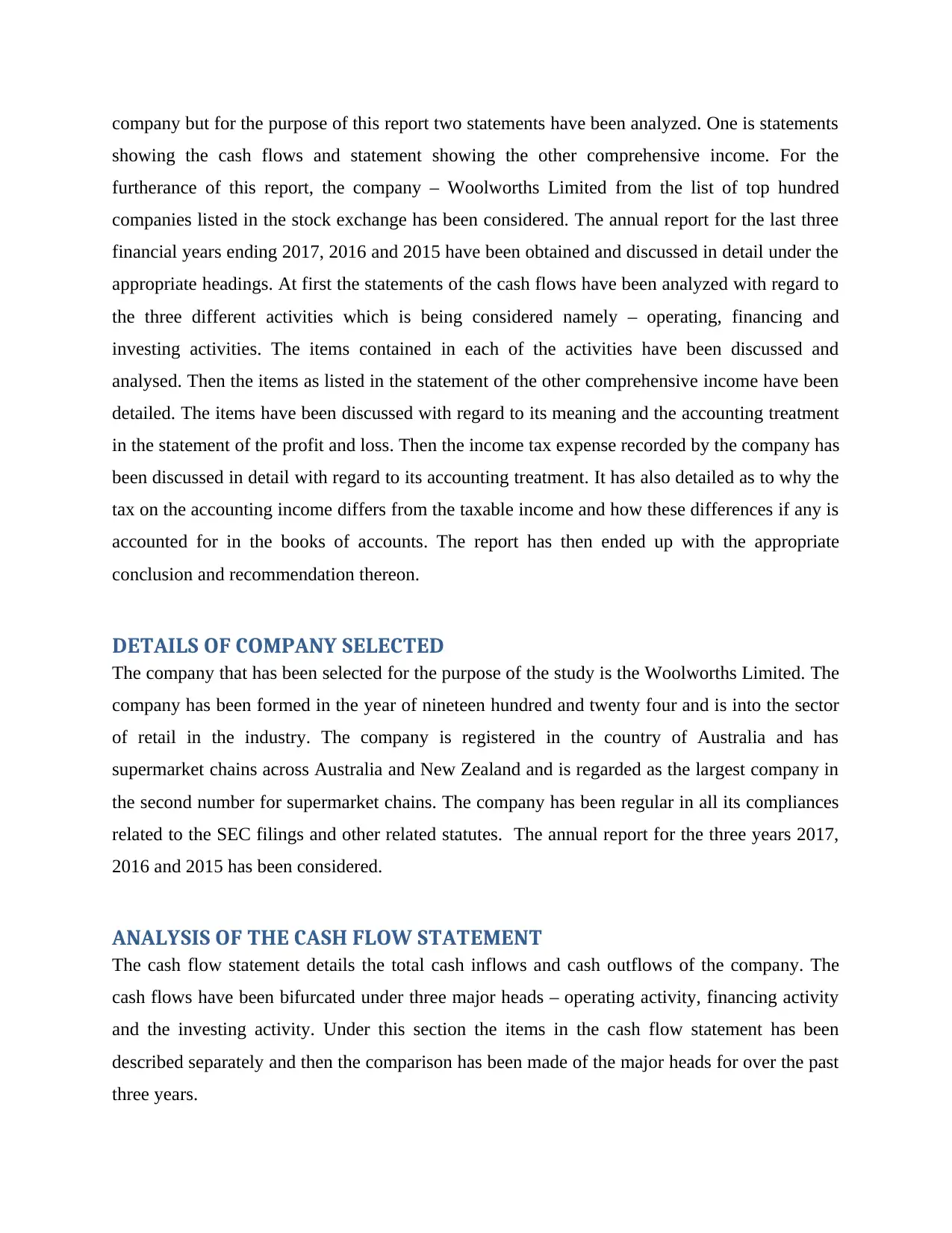
company but for the purpose of this report two statements have been analyzed. One is statements
showing the cash flows and statement showing the other comprehensive income. For the
furtherance of this report, the company – Woolworths Limited from the list of top hundred
companies listed in the stock exchange has been considered. The annual report for the last three
financial years ending 2017, 2016 and 2015 have been obtained and discussed in detail under the
appropriate headings. At first the statements of the cash flows have been analyzed with regard to
the three different activities which is being considered namely – operating, financing and
investing activities. The items contained in each of the activities have been discussed and
analysed. Then the items as listed in the statement of the other comprehensive income have been
detailed. The items have been discussed with regard to its meaning and the accounting treatment
in the statement of the profit and loss. Then the income tax expense recorded by the company has
been discussed in detail with regard to its accounting treatment. It has also detailed as to why the
tax on the accounting income differs from the taxable income and how these differences if any is
accounted for in the books of accounts. The report has then ended up with the appropriate
conclusion and recommendation thereon.
DETAILS OF COMPANY SELECTED
The company that has been selected for the purpose of the study is the Woolworths Limited. The
company has been formed in the year of nineteen hundred and twenty four and is into the sector
of retail in the industry. The company is registered in the country of Australia and has
supermarket chains across Australia and New Zealand and is regarded as the largest company in
the second number for supermarket chains. The company has been regular in all its compliances
related to the SEC filings and other related statutes. The annual report for the three years 2017,
2016 and 2015 has been considered.
ANALYSIS OF THE CASH FLOW STATEMENT
The cash flow statement details the total cash inflows and cash outflows of the company. The
cash flows have been bifurcated under three major heads – operating activity, financing activity
and the investing activity. Under this section the items in the cash flow statement has been
described separately and then the comparison has been made of the major heads for over the past
three years.
showing the cash flows and statement showing the other comprehensive income. For the
furtherance of this report, the company – Woolworths Limited from the list of top hundred
companies listed in the stock exchange has been considered. The annual report for the last three
financial years ending 2017, 2016 and 2015 have been obtained and discussed in detail under the
appropriate headings. At first the statements of the cash flows have been analyzed with regard to
the three different activities which is being considered namely – operating, financing and
investing activities. The items contained in each of the activities have been discussed and
analysed. Then the items as listed in the statement of the other comprehensive income have been
detailed. The items have been discussed with regard to its meaning and the accounting treatment
in the statement of the profit and loss. Then the income tax expense recorded by the company has
been discussed in detail with regard to its accounting treatment. It has also detailed as to why the
tax on the accounting income differs from the taxable income and how these differences if any is
accounted for in the books of accounts. The report has then ended up with the appropriate
conclusion and recommendation thereon.
DETAILS OF COMPANY SELECTED
The company that has been selected for the purpose of the study is the Woolworths Limited. The
company has been formed in the year of nineteen hundred and twenty four and is into the sector
of retail in the industry. The company is registered in the country of Australia and has
supermarket chains across Australia and New Zealand and is regarded as the largest company in
the second number for supermarket chains. The company has been regular in all its compliances
related to the SEC filings and other related statutes. The annual report for the three years 2017,
2016 and 2015 has been considered.
ANALYSIS OF THE CASH FLOW STATEMENT
The cash flow statement details the total cash inflows and cash outflows of the company. The
cash flows have been bifurcated under three major heads – operating activity, financing activity
and the investing activity. Under this section the items in the cash flow statement has been
described separately and then the comparison has been made of the major heads for over the past
three years.
⊘ This is a preview!⊘
Do you want full access?
Subscribe today to unlock all pages.

Trusted by 1+ million students worldwide
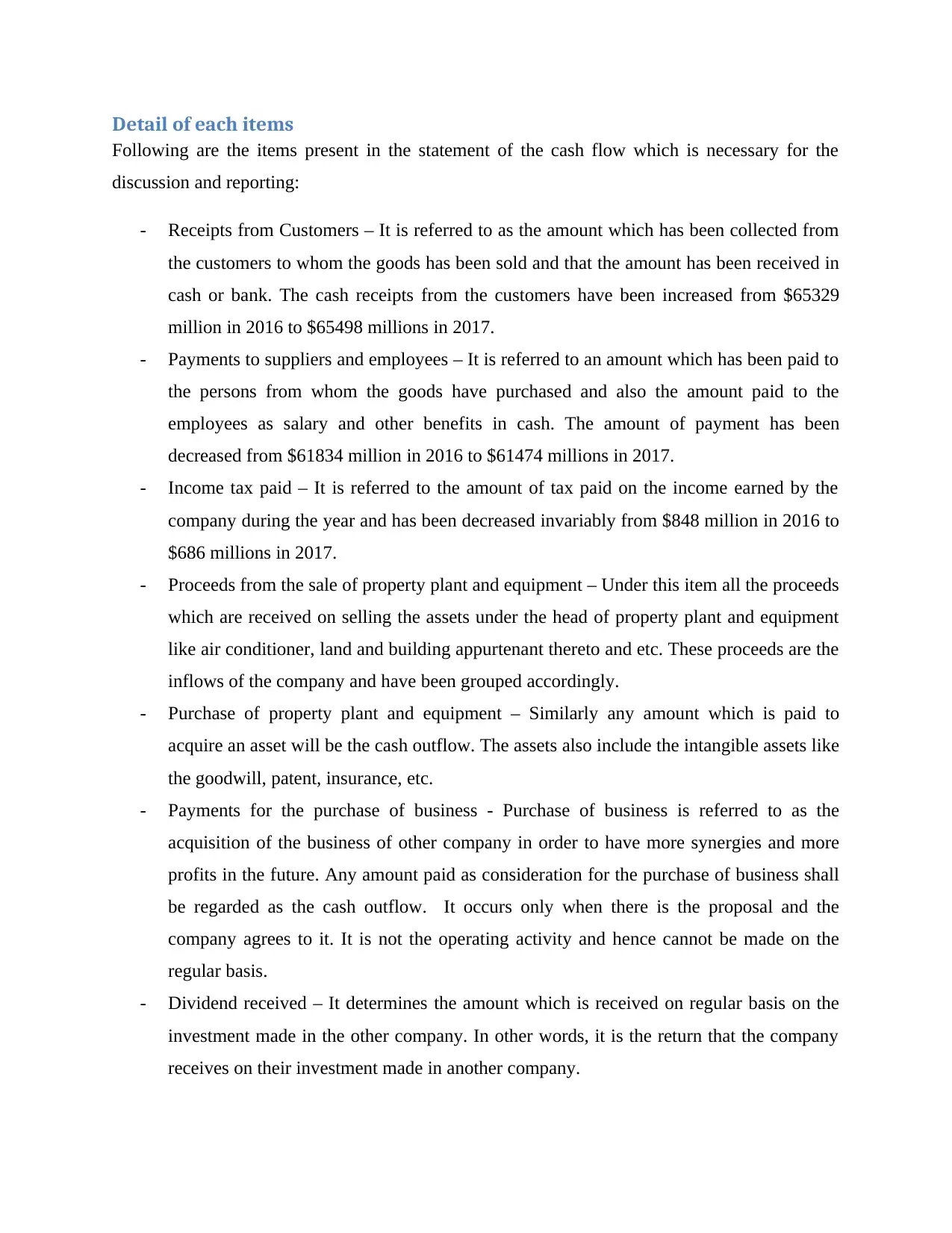
Detail of each items
Following are the items present in the statement of the cash flow which is necessary for the
discussion and reporting:
- Receipts from Customers – It is referred to as the amount which has been collected from
the customers to whom the goods has been sold and that the amount has been received in
cash or bank. The cash receipts from the customers have been increased from $65329
million in 2016 to $65498 millions in 2017.
- Payments to suppliers and employees – It is referred to an amount which has been paid to
the persons from whom the goods have purchased and also the amount paid to the
employees as salary and other benefits in cash. The amount of payment has been
decreased from $61834 million in 2016 to $61474 millions in 2017.
- Income tax paid – It is referred to the amount of tax paid on the income earned by the
company during the year and has been decreased invariably from $848 million in 2016 to
$686 millions in 2017.
- Proceeds from the sale of property plant and equipment – Under this item all the proceeds
which are received on selling the assets under the head of property plant and equipment
like air conditioner, land and building appurtenant thereto and etc. These proceeds are the
inflows of the company and have been grouped accordingly.
- Purchase of property plant and equipment – Similarly any amount which is paid to
acquire an asset will be the cash outflow. The assets also include the intangible assets like
the goodwill, patent, insurance, etc.
- Payments for the purchase of business - Purchase of business is referred to as the
acquisition of the business of other company in order to have more synergies and more
profits in the future. Any amount paid as consideration for the purchase of business shall
be regarded as the cash outflow. It occurs only when there is the proposal and the
company agrees to it. It is not the operating activity and hence cannot be made on the
regular basis.
- Dividend received – It determines the amount which is received on regular basis on the
investment made in the other company. In other words, it is the return that the company
receives on their investment made in another company.
Following are the items present in the statement of the cash flow which is necessary for the
discussion and reporting:
- Receipts from Customers – It is referred to as the amount which has been collected from
the customers to whom the goods has been sold and that the amount has been received in
cash or bank. The cash receipts from the customers have been increased from $65329
million in 2016 to $65498 millions in 2017.
- Payments to suppliers and employees – It is referred to an amount which has been paid to
the persons from whom the goods have purchased and also the amount paid to the
employees as salary and other benefits in cash. The amount of payment has been
decreased from $61834 million in 2016 to $61474 millions in 2017.
- Income tax paid – It is referred to the amount of tax paid on the income earned by the
company during the year and has been decreased invariably from $848 million in 2016 to
$686 millions in 2017.
- Proceeds from the sale of property plant and equipment – Under this item all the proceeds
which are received on selling the assets under the head of property plant and equipment
like air conditioner, land and building appurtenant thereto and etc. These proceeds are the
inflows of the company and have been grouped accordingly.
- Purchase of property plant and equipment – Similarly any amount which is paid to
acquire an asset will be the cash outflow. The assets also include the intangible assets like
the goodwill, patent, insurance, etc.
- Payments for the purchase of business - Purchase of business is referred to as the
acquisition of the business of other company in order to have more synergies and more
profits in the future. Any amount paid as consideration for the purchase of business shall
be regarded as the cash outflow. It occurs only when there is the proposal and the
company agrees to it. It is not the operating activity and hence cannot be made on the
regular basis.
- Dividend received – It determines the amount which is received on regular basis on the
investment made in the other company. In other words, it is the return that the company
receives on their investment made in another company.
Paraphrase This Document
Need a fresh take? Get an instant paraphrase of this document with our AI Paraphraser
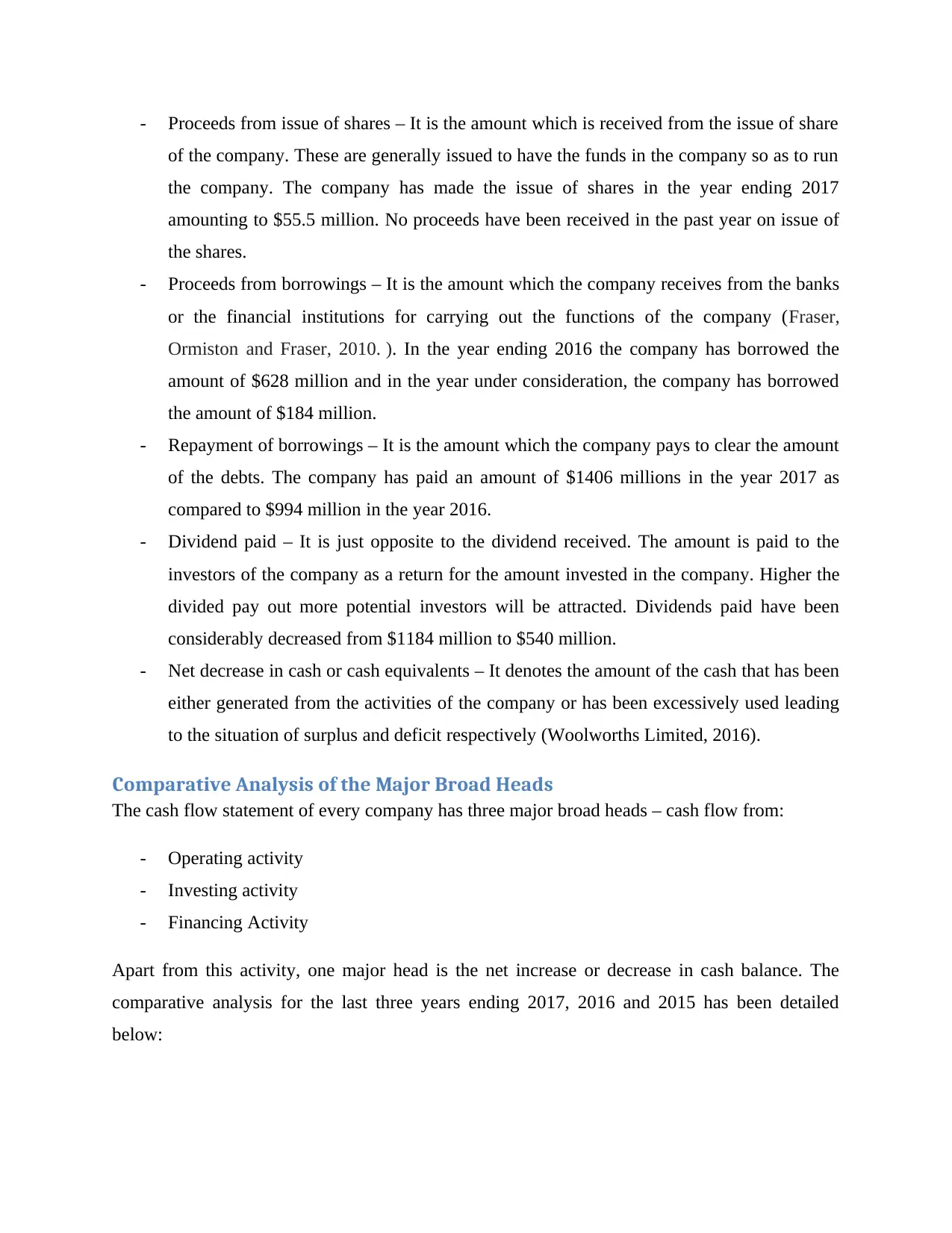
- Proceeds from issue of shares – It is the amount which is received from the issue of share
of the company. These are generally issued to have the funds in the company so as to run
the company. The company has made the issue of shares in the year ending 2017
amounting to $55.5 million. No proceeds have been received in the past year on issue of
the shares.
- Proceeds from borrowings – It is the amount which the company receives from the banks
or the financial institutions for carrying out the functions of the company (Fraser,
Ormiston and Fraser, 2010. ). In the year ending 2016 the company has borrowed the
amount of $628 million and in the year under consideration, the company has borrowed
the amount of $184 million.
- Repayment of borrowings – It is the amount which the company pays to clear the amount
of the debts. The company has paid an amount of $1406 millions in the year 2017 as
compared to $994 million in the year 2016.
- Dividend paid – It is just opposite to the dividend received. The amount is paid to the
investors of the company as a return for the amount invested in the company. Higher the
divided pay out more potential investors will be attracted. Dividends paid have been
considerably decreased from $1184 million to $540 million.
- Net decrease in cash or cash equivalents – It denotes the amount of the cash that has been
either generated from the activities of the company or has been excessively used leading
to the situation of surplus and deficit respectively (Woolworths Limited, 2016).
Comparative Analysis of the Major Broad Heads
The cash flow statement of every company has three major broad heads – cash flow from:
- Operating activity
- Investing activity
- Financing Activity
Apart from this activity, one major head is the net increase or decrease in cash balance. The
comparative analysis for the last three years ending 2017, 2016 and 2015 has been detailed
below:
of the company. These are generally issued to have the funds in the company so as to run
the company. The company has made the issue of shares in the year ending 2017
amounting to $55.5 million. No proceeds have been received in the past year on issue of
the shares.
- Proceeds from borrowings – It is the amount which the company receives from the banks
or the financial institutions for carrying out the functions of the company (Fraser,
Ormiston and Fraser, 2010. ). In the year ending 2016 the company has borrowed the
amount of $628 million and in the year under consideration, the company has borrowed
the amount of $184 million.
- Repayment of borrowings – It is the amount which the company pays to clear the amount
of the debts. The company has paid an amount of $1406 millions in the year 2017 as
compared to $994 million in the year 2016.
- Dividend paid – It is just opposite to the dividend received. The amount is paid to the
investors of the company as a return for the amount invested in the company. Higher the
divided pay out more potential investors will be attracted. Dividends paid have been
considerably decreased from $1184 million to $540 million.
- Net decrease in cash or cash equivalents – It denotes the amount of the cash that has been
either generated from the activities of the company or has been excessively used leading
to the situation of surplus and deficit respectively (Woolworths Limited, 2016).
Comparative Analysis of the Major Broad Heads
The cash flow statement of every company has three major broad heads – cash flow from:
- Operating activity
- Investing activity
- Financing Activity
Apart from this activity, one major head is the net increase or decrease in cash balance. The
comparative analysis for the last three years ending 2017, 2016 and 2015 has been detailed
below:
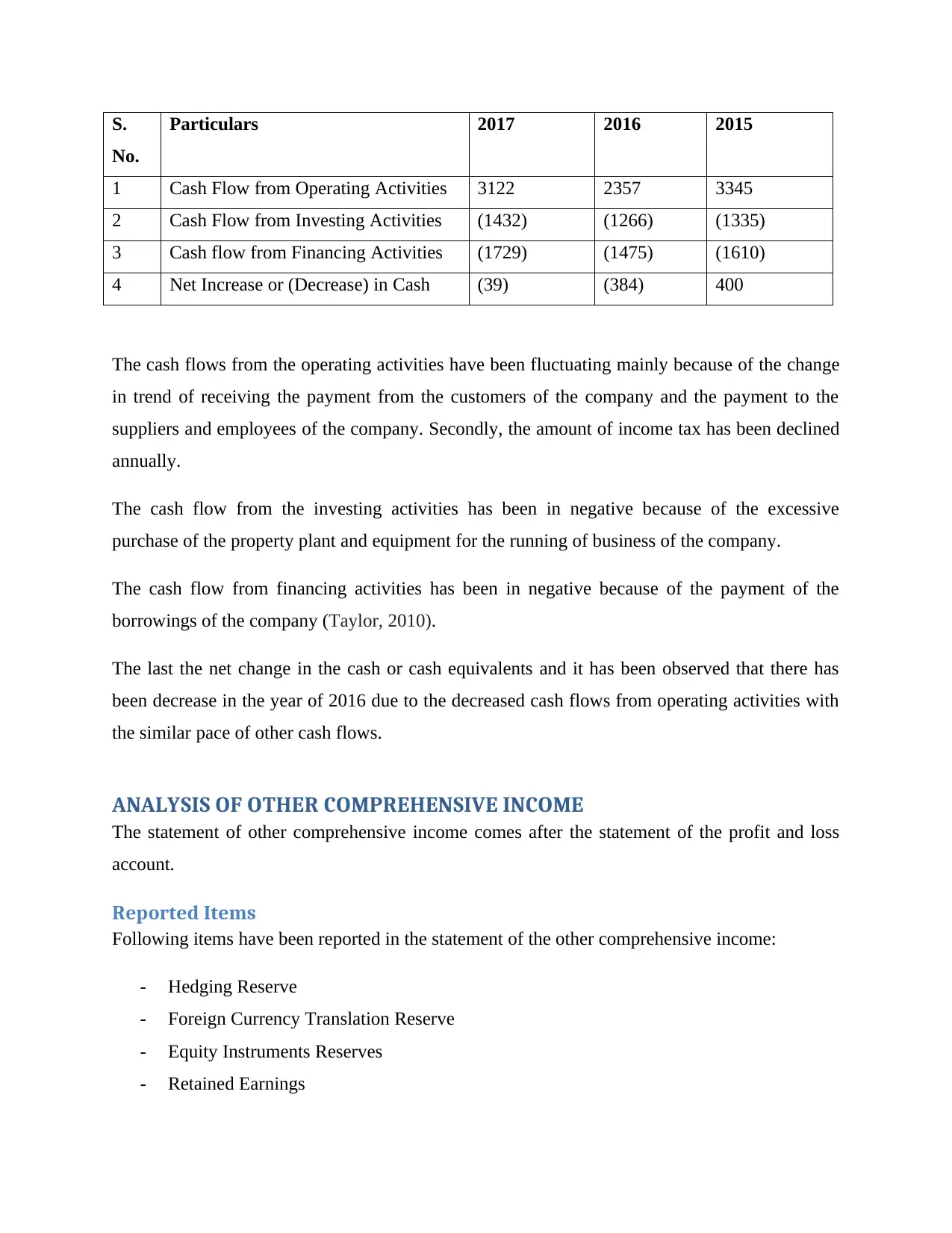
S.
No.
Particulars 2017 2016 2015
1 Cash Flow from Operating Activities 3122 2357 3345
2 Cash Flow from Investing Activities (1432) (1266) (1335)
3 Cash flow from Financing Activities (1729) (1475) (1610)
4 Net Increase or (Decrease) in Cash (39) (384) 400
The cash flows from the operating activities have been fluctuating mainly because of the change
in trend of receiving the payment from the customers of the company and the payment to the
suppliers and employees of the company. Secondly, the amount of income tax has been declined
annually.
The cash flow from the investing activities has been in negative because of the excessive
purchase of the property plant and equipment for the running of business of the company.
The cash flow from financing activities has been in negative because of the payment of the
borrowings of the company (Taylor, 2010).
The last the net change in the cash or cash equivalents and it has been observed that there has
been decrease in the year of 2016 due to the decreased cash flows from operating activities with
the similar pace of other cash flows.
ANALYSIS OF OTHER COMPREHENSIVE INCOME
The statement of other comprehensive income comes after the statement of the profit and loss
account.
Reported Items
Following items have been reported in the statement of the other comprehensive income:
- Hedging Reserve
- Foreign Currency Translation Reserve
- Equity Instruments Reserves
- Retained Earnings
No.
Particulars 2017 2016 2015
1 Cash Flow from Operating Activities 3122 2357 3345
2 Cash Flow from Investing Activities (1432) (1266) (1335)
3 Cash flow from Financing Activities (1729) (1475) (1610)
4 Net Increase or (Decrease) in Cash (39) (384) 400
The cash flows from the operating activities have been fluctuating mainly because of the change
in trend of receiving the payment from the customers of the company and the payment to the
suppliers and employees of the company. Secondly, the amount of income tax has been declined
annually.
The cash flow from the investing activities has been in negative because of the excessive
purchase of the property plant and equipment for the running of business of the company.
The cash flow from financing activities has been in negative because of the payment of the
borrowings of the company (Taylor, 2010).
The last the net change in the cash or cash equivalents and it has been observed that there has
been decrease in the year of 2016 due to the decreased cash flows from operating activities with
the similar pace of other cash flows.
ANALYSIS OF OTHER COMPREHENSIVE INCOME
The statement of other comprehensive income comes after the statement of the profit and loss
account.
Reported Items
Following items have been reported in the statement of the other comprehensive income:
- Hedging Reserve
- Foreign Currency Translation Reserve
- Equity Instruments Reserves
- Retained Earnings
⊘ This is a preview!⊘
Do you want full access?
Subscribe today to unlock all pages.

Trusted by 1+ million students worldwide
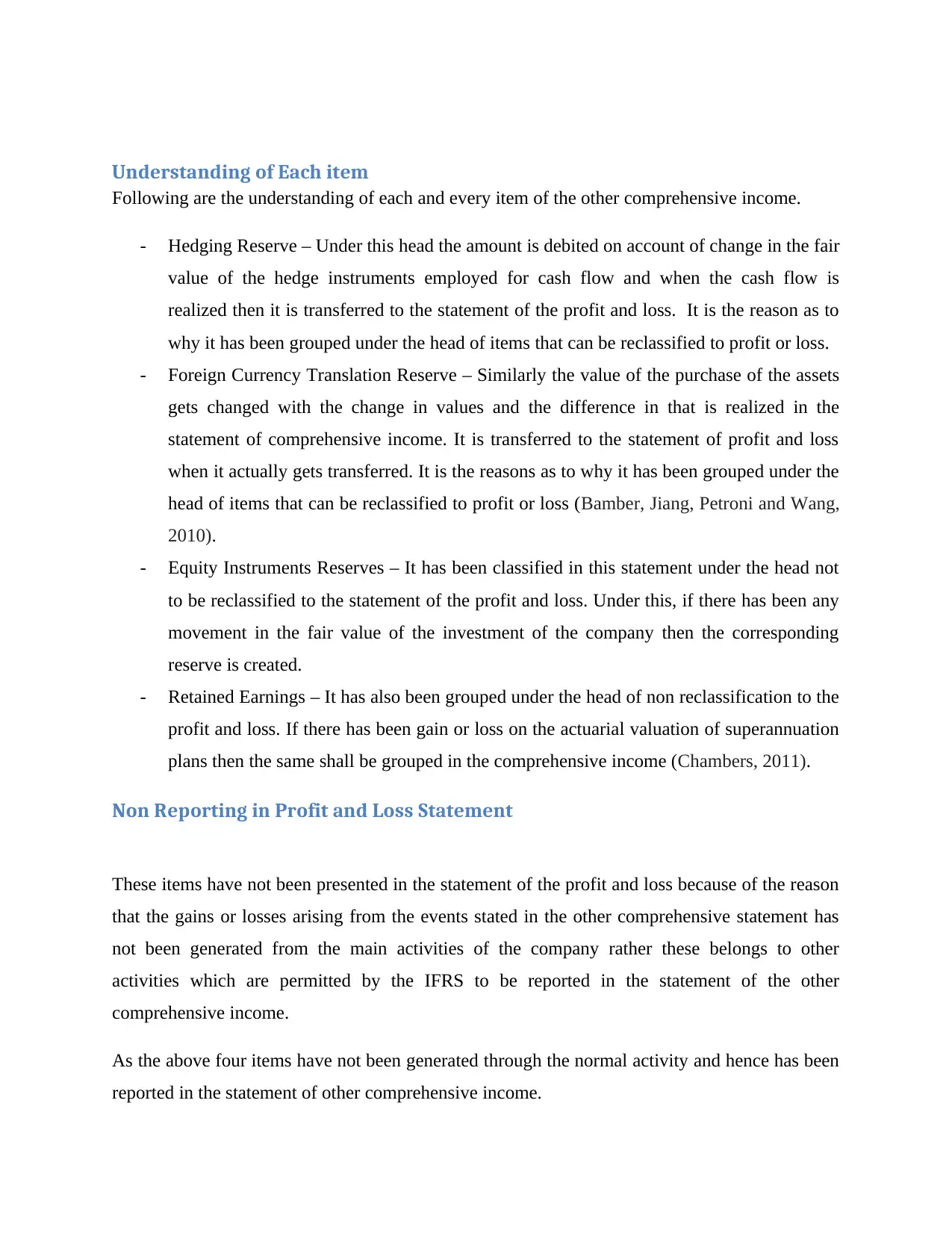
Understanding of Each item
Following are the understanding of each and every item of the other comprehensive income.
- Hedging Reserve – Under this head the amount is debited on account of change in the fair
value of the hedge instruments employed for cash flow and when the cash flow is
realized then it is transferred to the statement of the profit and loss. It is the reason as to
why it has been grouped under the head of items that can be reclassified to profit or loss.
- Foreign Currency Translation Reserve – Similarly the value of the purchase of the assets
gets changed with the change in values and the difference in that is realized in the
statement of comprehensive income. It is transferred to the statement of profit and loss
when it actually gets transferred. It is the reasons as to why it has been grouped under the
head of items that can be reclassified to profit or loss (Bamber, Jiang, Petroni and Wang,
2010).
- Equity Instruments Reserves – It has been classified in this statement under the head not
to be reclassified to the statement of the profit and loss. Under this, if there has been any
movement in the fair value of the investment of the company then the corresponding
reserve is created.
- Retained Earnings – It has also been grouped under the head of non reclassification to the
profit and loss. If there has been gain or loss on the actuarial valuation of superannuation
plans then the same shall be grouped in the comprehensive income (Chambers, 2011).
Non Reporting in Profit and Loss Statement
These items have not been presented in the statement of the profit and loss because of the reason
that the gains or losses arising from the events stated in the other comprehensive statement has
not been generated from the main activities of the company rather these belongs to other
activities which are permitted by the IFRS to be reported in the statement of the other
comprehensive income.
As the above four items have not been generated through the normal activity and hence has been
reported in the statement of other comprehensive income.
Following are the understanding of each and every item of the other comprehensive income.
- Hedging Reserve – Under this head the amount is debited on account of change in the fair
value of the hedge instruments employed for cash flow and when the cash flow is
realized then it is transferred to the statement of the profit and loss. It is the reason as to
why it has been grouped under the head of items that can be reclassified to profit or loss.
- Foreign Currency Translation Reserve – Similarly the value of the purchase of the assets
gets changed with the change in values and the difference in that is realized in the
statement of comprehensive income. It is transferred to the statement of profit and loss
when it actually gets transferred. It is the reasons as to why it has been grouped under the
head of items that can be reclassified to profit or loss (Bamber, Jiang, Petroni and Wang,
2010).
- Equity Instruments Reserves – It has been classified in this statement under the head not
to be reclassified to the statement of the profit and loss. Under this, if there has been any
movement in the fair value of the investment of the company then the corresponding
reserve is created.
- Retained Earnings – It has also been grouped under the head of non reclassification to the
profit and loss. If there has been gain or loss on the actuarial valuation of superannuation
plans then the same shall be grouped in the comprehensive income (Chambers, 2011).
Non Reporting in Profit and Loss Statement
These items have not been presented in the statement of the profit and loss because of the reason
that the gains or losses arising from the events stated in the other comprehensive statement has
not been generated from the main activities of the company rather these belongs to other
activities which are permitted by the IFRS to be reported in the statement of the other
comprehensive income.
As the above four items have not been generated through the normal activity and hence has been
reported in the statement of other comprehensive income.
Paraphrase This Document
Need a fresh take? Get an instant paraphrase of this document with our AI Paraphraser
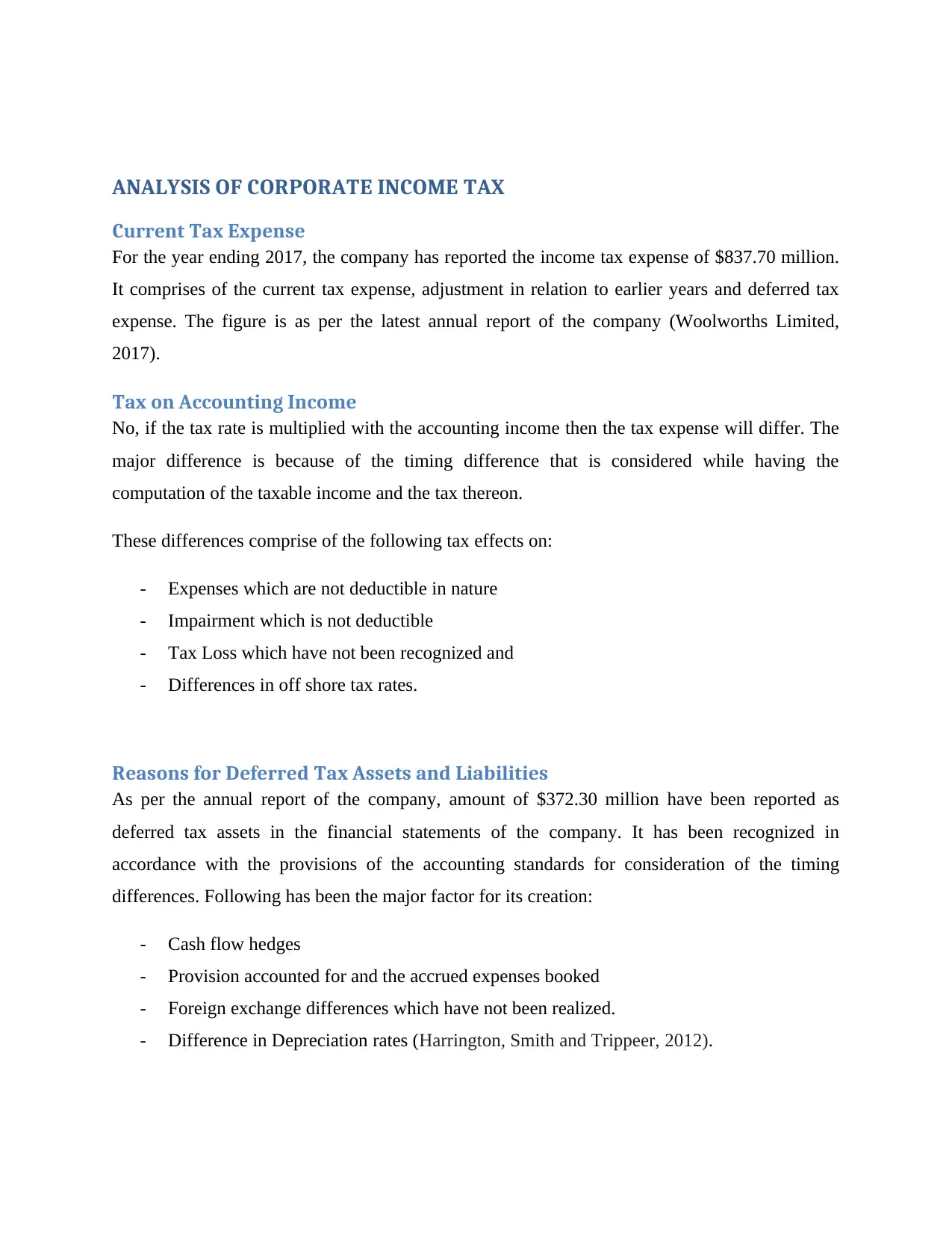
ANALYSIS OF CORPORATE INCOME TAX
Current Tax Expense
For the year ending 2017, the company has reported the income tax expense of $837.70 million.
It comprises of the current tax expense, adjustment in relation to earlier years and deferred tax
expense. The figure is as per the latest annual report of the company (Woolworths Limited,
2017).
Tax on Accounting Income
No, if the tax rate is multiplied with the accounting income then the tax expense will differ. The
major difference is because of the timing difference that is considered while having the
computation of the taxable income and the tax thereon.
These differences comprise of the following tax effects on:
- Expenses which are not deductible in nature
- Impairment which is not deductible
- Tax Loss which have not been recognized and
- Differences in off shore tax rates.
Reasons for Deferred Tax Assets and Liabilities
As per the annual report of the company, amount of $372.30 million have been reported as
deferred tax assets in the financial statements of the company. It has been recognized in
accordance with the provisions of the accounting standards for consideration of the timing
differences. Following has been the major factor for its creation:
- Cash flow hedges
- Provision accounted for and the accrued expenses booked
- Foreign exchange differences which have not been realized.
- Difference in Depreciation rates (Harrington, Smith and Trippeer, 2012).
Current Tax Expense
For the year ending 2017, the company has reported the income tax expense of $837.70 million.
It comprises of the current tax expense, adjustment in relation to earlier years and deferred tax
expense. The figure is as per the latest annual report of the company (Woolworths Limited,
2017).
Tax on Accounting Income
No, if the tax rate is multiplied with the accounting income then the tax expense will differ. The
major difference is because of the timing difference that is considered while having the
computation of the taxable income and the tax thereon.
These differences comprise of the following tax effects on:
- Expenses which are not deductible in nature
- Impairment which is not deductible
- Tax Loss which have not been recognized and
- Differences in off shore tax rates.
Reasons for Deferred Tax Assets and Liabilities
As per the annual report of the company, amount of $372.30 million have been reported as
deferred tax assets in the financial statements of the company. It has been recognized in
accordance with the provisions of the accounting standards for consideration of the timing
differences. Following has been the major factor for its creation:
- Cash flow hedges
- Provision accounted for and the accrued expenses booked
- Foreign exchange differences which have not been realized.
- Difference in Depreciation rates (Harrington, Smith and Trippeer, 2012).
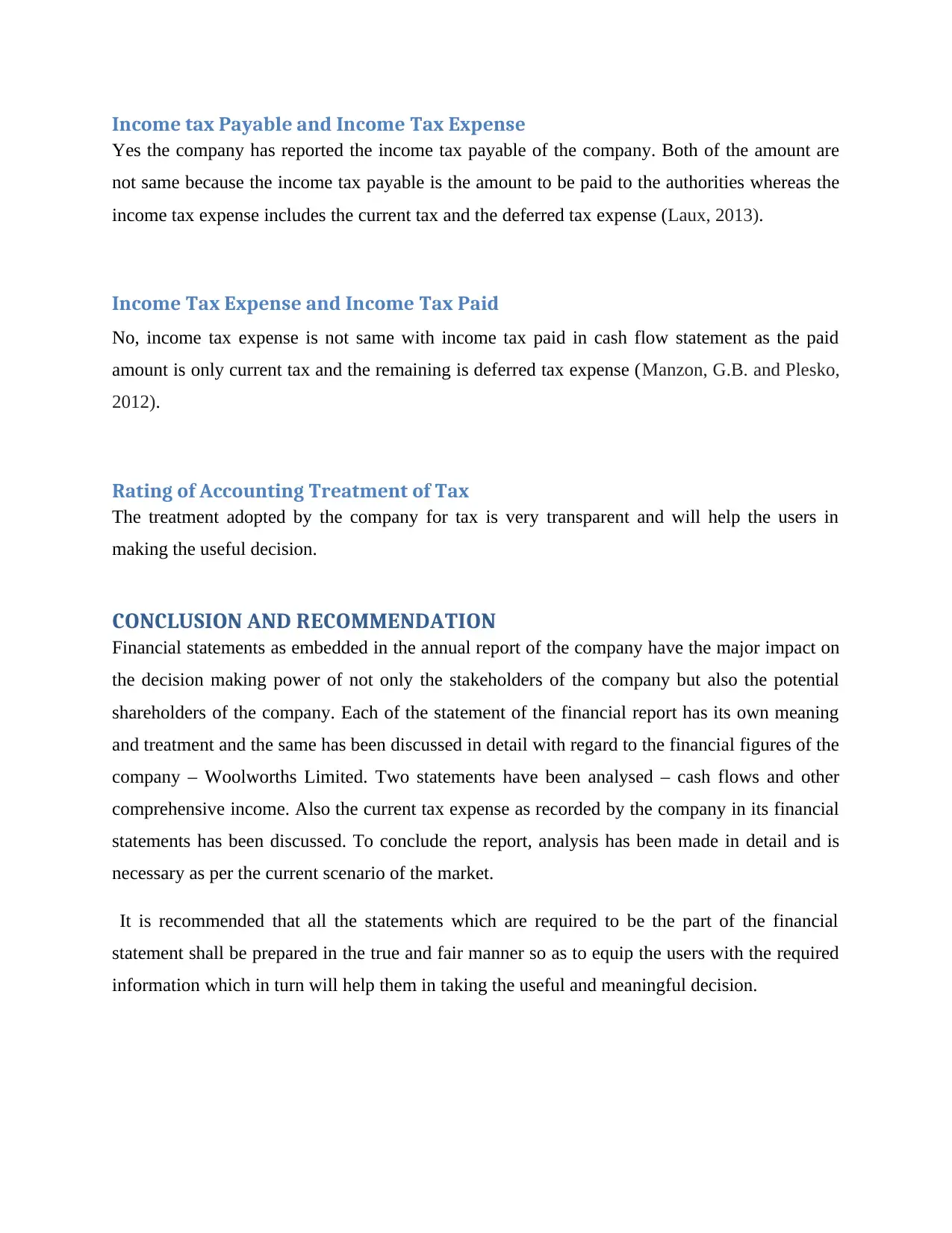
Income tax Payable and Income Tax Expense
Yes the company has reported the income tax payable of the company. Both of the amount are
not same because the income tax payable is the amount to be paid to the authorities whereas the
income tax expense includes the current tax and the deferred tax expense (Laux, 2013).
Income Tax Expense and Income Tax Paid
No, income tax expense is not same with income tax paid in cash flow statement as the paid
amount is only current tax and the remaining is deferred tax expense (Manzon, G.B. and Plesko,
2012).
Rating of Accounting Treatment of Tax
The treatment adopted by the company for tax is very transparent and will help the users in
making the useful decision.
CONCLUSION AND RECOMMENDATION
Financial statements as embedded in the annual report of the company have the major impact on
the decision making power of not only the stakeholders of the company but also the potential
shareholders of the company. Each of the statement of the financial report has its own meaning
and treatment and the same has been discussed in detail with regard to the financial figures of the
company – Woolworths Limited. Two statements have been analysed – cash flows and other
comprehensive income. Also the current tax expense as recorded by the company in its financial
statements has been discussed. To conclude the report, analysis has been made in detail and is
necessary as per the current scenario of the market.
It is recommended that all the statements which are required to be the part of the financial
statement shall be prepared in the true and fair manner so as to equip the users with the required
information which in turn will help them in taking the useful and meaningful decision.
Yes the company has reported the income tax payable of the company. Both of the amount are
not same because the income tax payable is the amount to be paid to the authorities whereas the
income tax expense includes the current tax and the deferred tax expense (Laux, 2013).
Income Tax Expense and Income Tax Paid
No, income tax expense is not same with income tax paid in cash flow statement as the paid
amount is only current tax and the remaining is deferred tax expense (Manzon, G.B. and Plesko,
2012).
Rating of Accounting Treatment of Tax
The treatment adopted by the company for tax is very transparent and will help the users in
making the useful decision.
CONCLUSION AND RECOMMENDATION
Financial statements as embedded in the annual report of the company have the major impact on
the decision making power of not only the stakeholders of the company but also the potential
shareholders of the company. Each of the statement of the financial report has its own meaning
and treatment and the same has been discussed in detail with regard to the financial figures of the
company – Woolworths Limited. Two statements have been analysed – cash flows and other
comprehensive income. Also the current tax expense as recorded by the company in its financial
statements has been discussed. To conclude the report, analysis has been made in detail and is
necessary as per the current scenario of the market.
It is recommended that all the statements which are required to be the part of the financial
statement shall be prepared in the true and fair manner so as to equip the users with the required
information which in turn will help them in taking the useful and meaningful decision.
⊘ This is a preview!⊘
Do you want full access?
Subscribe today to unlock all pages.

Trusted by 1+ million students worldwide
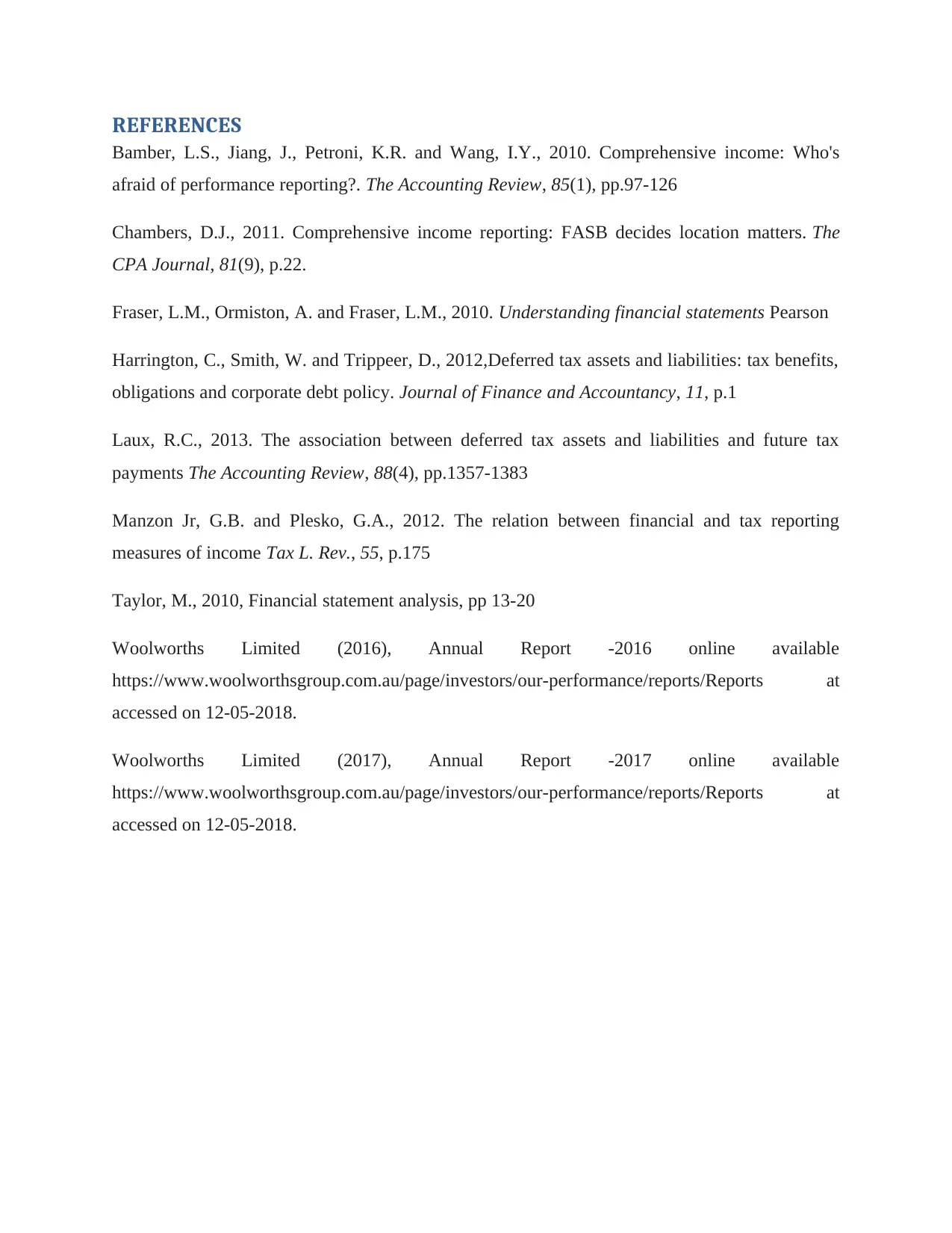
REFERENCES
Bamber, L.S., Jiang, J., Petroni, K.R. and Wang, I.Y., 2010. Comprehensive income: Who's
afraid of performance reporting?. The Accounting Review, 85(1), pp.97-126
Chambers, D.J., 2011. Comprehensive income reporting: FASB decides location matters. The
CPA Journal, 81(9), p.22.
Fraser, L.M., Ormiston, A. and Fraser, L.M., 2010. Understanding financial statements Pearson
Harrington, C., Smith, W. and Trippeer, D., 2012,Deferred tax assets and liabilities: tax benefits,
obligations and corporate debt policy. Journal of Finance and Accountancy, 11, p.1
Laux, R.C., 2013. The association between deferred tax assets and liabilities and future tax
payments The Accounting Review, 88(4), pp.1357-1383
Manzon Jr, G.B. and Plesko, G.A., 2012. The relation between financial and tax reporting
measures of income Tax L. Rev., 55, p.175
Taylor, M., 2010, Financial statement analysis, pp 13-20
Woolworths Limited (2016), Annual Report -2016 online available
https://www.woolworthsgroup.com.au/page/investors/our-performance/reports/Reports at
accessed on 12-05-2018.
Woolworths Limited (2017), Annual Report -2017 online available
https://www.woolworthsgroup.com.au/page/investors/our-performance/reports/Reports at
accessed on 12-05-2018.
Bamber, L.S., Jiang, J., Petroni, K.R. and Wang, I.Y., 2010. Comprehensive income: Who's
afraid of performance reporting?. The Accounting Review, 85(1), pp.97-126
Chambers, D.J., 2011. Comprehensive income reporting: FASB decides location matters. The
CPA Journal, 81(9), p.22.
Fraser, L.M., Ormiston, A. and Fraser, L.M., 2010. Understanding financial statements Pearson
Harrington, C., Smith, W. and Trippeer, D., 2012,Deferred tax assets and liabilities: tax benefits,
obligations and corporate debt policy. Journal of Finance and Accountancy, 11, p.1
Laux, R.C., 2013. The association between deferred tax assets and liabilities and future tax
payments The Accounting Review, 88(4), pp.1357-1383
Manzon Jr, G.B. and Plesko, G.A., 2012. The relation between financial and tax reporting
measures of income Tax L. Rev., 55, p.175
Taylor, M., 2010, Financial statement analysis, pp 13-20
Woolworths Limited (2016), Annual Report -2016 online available
https://www.woolworthsgroup.com.au/page/investors/our-performance/reports/Reports at
accessed on 12-05-2018.
Woolworths Limited (2017), Annual Report -2017 online available
https://www.woolworthsgroup.com.au/page/investors/our-performance/reports/Reports at
accessed on 12-05-2018.
1 out of 10
Related Documents
Your All-in-One AI-Powered Toolkit for Academic Success.
+13062052269
info@desklib.com
Available 24*7 on WhatsApp / Email
![[object Object]](/_next/static/media/star-bottom.7253800d.svg)
Unlock your academic potential
Copyright © 2020–2025 A2Z Services. All Rights Reserved. Developed and managed by ZUCOL.



